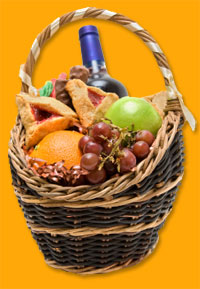Mishloach Manot (Purim Gift Baskets)
Purim is the Jewish calendar’s most fun-filled holiday. Everyone from toddlers to grandparents dress-up in costume, families and friends enjoy feasts together, and alcohol is imbibed – liberally.
costume, families and friends enjoy feasts together, and alcohol is imbibed – liberally.
Two other quintessential Purim customs are giving gifts of food to friends and gifts of charity to the poor. What is the significance of these customs? And why are they unique to Purim?
Gifts to the Poor: Matanot L’Evyonim
On that first Purim in Persia, King Achashverus’ evil advisor Haman plotted to kill all the Jews. Queen Esther and her uncle Mordechai interceded and saved the day – and the Jewish people.
Their heroism is considered a lesson in the unity of the Jewish people: the community will rise – or fall – together. Just as Haman had plotted to kill all the Jews, Esther’s heroism had saved all the Jews.
This lesson is the inspiration behind Purim’s special mitzvah – or commandment – to give charity to the poor: If one person doesn’t have enough, then no one has enough. If one person cannot rise, then all will fall.
Further reinforcing this lesson is the specific proscription to give three half-dollar coins to charity. The half-dollar is a symbolic amount – reminding the giver that he or she is only part of a larger whole
The charity custom further proscribes that everyone – rich and poor – give the same amount of charity, reminding Purim revelers again that every person has an equally critical role in the destiny of the Jewish people.
Gifts to Friends: Mishloach Manot
Another special mitzvah on Purim is giving food baskets to friends and family. On Purim morning, costumed youngsters deliver multiple baskets, filled with sweet or savory treats.
The custom, known as Mishloach Manot or “sending portions”, proscribes that the basket contain two different types of ready to eat food. There are two rationales behind this custom. The first reason is ultra-practical: to ensure that everyone has enough food to enjoy the Purim feast held later that day.
The second reason for giving gift baskets is more esoteric: to increase the feelings of friendship and love. Harkening back to Haman’s evil plot to destroy the Jews, the gift giving custom is an attempt to perennially repair that rift.
If you would like to experience the joy of giving gift baskets on Purim, start by making a list of all your friends, neighbors, family members, parents of your children’s friends… the list is endless!
Then think about what kind of Mishloach Manot you want to send. A traditional gift basket might include a small bottle of grape juice, somehamantashen – the quintessential Purim pastry stuffed with poppy seed, candy and perhaps some dried fruit and nuts.
To fulfill the commandment of giving Mishloach Manot, you must be sure to label your gift basket both with the gift givers’ names and the recipients’ names. Involve children in the festivities by letting them make the cards to attach to your basket.
Beyond Hamantashen: Getting Creative with Purim Food Baskets (Mishloach Manot)



